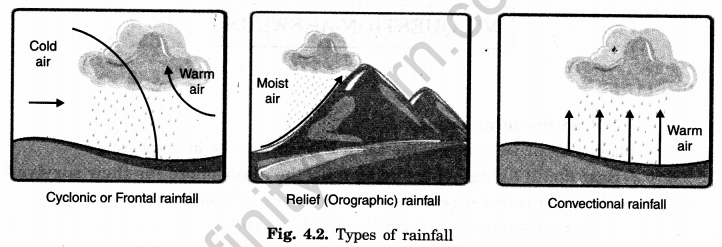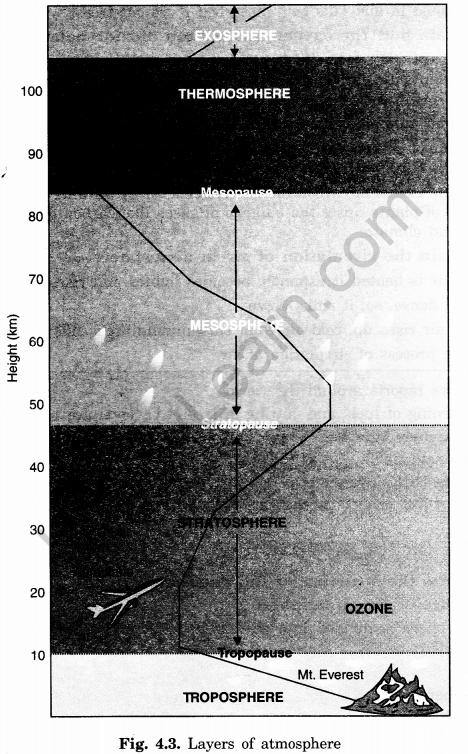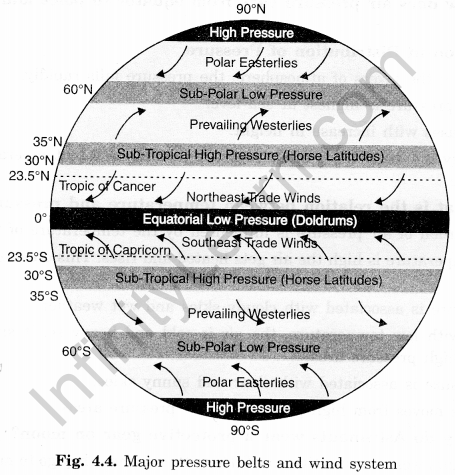Air Class 7 Extra Questions Social Science Geography Chapter 4
NCERT Extra Questions for Class 7 Social Science Geography Chapter 4 Air
Prelude
Question 1.
Define the term atmosphere.
Answer:
Blanket of air surrounding the earth is known as the atmosphere.
Question 2.
How do all living beings depend on the atmosphere for their survival?
Answer:
All living beings depend on the atmosphere for their survival.
- Atmosphere provides them the air they breathe.
- It protects them from the harmful effects of the sun’s rays.
- Without its protection, they would be baked alive by the heat of the sun during day and get frozen during night.
Question 3.
What is green house effect?
Answer:
Carbon dioxide in the atmosphere traps the heat radiated from the earth creating a green house effect. This makes the temperatures livable. Without this earth would have been too cold to live. But the increased emissions from vehicles and factories increases the temperature leading to global warming.
Question 4.
What is global warming? What is its affect?
Answer:
When the heat retained through greenhouse gas increases the temperature of the earth, it causes global warming:
- The plants maintain the balance of gases. However this balance is upset by burning fuels such as coal, petroleum oil and large scale deforestation.
- This rise in temperature causes the snow in coldest parts to melt.
- As a result the sea level rises causing floods in the coastal areas.
- This may bring changes in weather and climate leading to extinction of certain plants and animal species.
Composition of the Atmosphere
Question 1.
Name the two gases which influence the atmosphere to a great extent.
Answer:
- Two gases such as carbon dioxide and ozone influence the atmosphere to a large extent.
- Their percentage in the atmosphere is as under:
- Carbon dioxide 0.03%
- Ozone 0.00006%
Question 2.
Describe the composition of the atmosphere.
Answer:
Composition of the Atmosphere:
- The air we inhale while breathing is actually a mixture of numerous gases.
- Nitrogen and oxygen are two gases which make up the most of the atmosphere.
- Carbon dioxide, helium, ozone, argon and hydrogen are found in lesser quantities.
- Tiny dust particles are also present in the air.

Question 3.
How is nitrogen present in atmosphere used by plants?
Answer:
Nitrogen is the most plentiful gas in the air.
- Plants need nitrogen for their survival. They cannot take nitrogen directly from the air.
- Bacteria in the soil or the roots fix nitrogen by changing its form so that plants can use it.
Question 4.
Which is the second most plentiful gas in the atmosphere?
Answer:
Oxygen is the second most plentiful gas in the atmosphere. Humans and animals use it for breathing. Green plants produce oxygen through photosynthesis and thus oxygen balance is maintained in air. This gets disturbed if we cut trees.
Question 5.
Explain how the oxygen and carbon dioxide balance is maintained in air?
Answer:
Green plants use carbon dioxide to make their food and during this process release oxygen:
- Humans and animals release carbon dioxide and take oxygen from air.
- The amount of carbon dioxide released by them is equal to amount used by plants
to make their food. Hence a balance is maintained. - But now the excess of carbon dioxide is released by burning of fuels. The reduction in number of plants upset the balance of gases like carbon dioxide affecting earth’s weather and climate.
Question 6.
Explain the circulation of air in atmosphere.
Answer:
When air is heated it expands, becomes lighter and rises up:
- Cold air is dense, so, it sinks down.
- When hot air rises up, cold air from surrounding areas fills in the gap.
- This is the process of circulation of air.
NOTES: News reports around the world
- Due to burning of fuels and cutting of trees C02 level are increasing
- Globed sunscreen thinned
- Warning unstoppable
- It can bring back Jurassic era.
Structure of the Atmosphere
Question 1.
Discuss the structure of the atmosphere.
Answer:
Structure of the Atmosphere:
The atmosphere is divided into five layers according to height, starting from the earth’s surface.
They are
- Troposphere
- Stratosphere
- Mesosphere
- Thermosphere
- Exosphere
Question 2.
Which is most important layer of the atmosphere?
Answer:
Troposphere
- Troposphere is the important layer of the atmosphere.
- Its average height is 13 km.
- It is 8 kilometres on the poles and 18 kilometres on the equator.
- The air (which living beings breathe) exists here.
- All the weather phenomena like winds, rainfall, fog, hailstorm etc. occur in this layer.

Question 3.
Which layer the most suitable conditions for flying aeroplanes?
Answer:
Stratosphere:
- The stratosphere lies above the troposphere.
- It extends up to a height of 50 km.
- This layer is almost free from clouds.
- No weather phenomenon occurs in this layer making conditions most ideal for flying aeroplanes.
- Stratosphere contains a layer of ozone gas.
- It protects living beings from the harmful effects of the sun rays.
Question 4.
What is the third layer of atmosphere?
Answer:
Mesosphere:
- Mesosphere is the third layer of the atmosphere.
- It lies above the stratosphere.
- It extends up to a height of 80 km.
- Meteorites bum up in this layer on entering from the space.
Question 5.
Briefly write about thermosphere?
Answer:
Thermosphere
- In thermosphere temperature rises very rapidly with increasing height.
- Ionosphere is a part of this layer.
- It extends between 80 and 400 km.
- This layer helps in radio transmission.
- Radio waves transmitted from the earth are reflected back to the earth by this layer.
Question 6.
Which is the uppermost layer of the atmosphere?
Answer:
Exosphere
- The uppermost layer of the atmosphere is known as exosphere.
- This layer has very thin air.
- Light gases like helium and hydrogen float into the space from here.
Weather and Climate
NOTES: Many questions are asked about days conditions especially on an important day like cricket match or wedding etc. Questions like’ will it rain or will it be sunny; etc. basically are related to day’s weather. Such questions are not asked about climate
Question 1.
What is weather?
Answer:
Weather is the day to day condition of the atmosphere. For example a sunny day or rainy day. Weather is like a control knob of climate.
Question 2.
Define the term climate.
Answer:
The sum total of all weather conditions prevailing over large area for a longer period of time is called climate.
Question 3.
What is the difference between weather and climate?
Answer:
Weather is hour-hour conditions of atmosphere like hot humid weather may make us irritable but same day breezy or pleasant evening may make one cheerful. We have hot or cold climate over a period of few months.
Therefore we have daily forecast of weather and long term predictions of climatic conditions.
Question 4.
Name different types of weather measuring instruments.
Answer:
Thermometer – measures temperature
Barometer – measures atmospheric pressure
Rain gauge – measures amount of rainfall
Wind wane – shows direction of wind
Temperature
Question 1.
What is temperature?
Answer:
- The degree of hotness or coldness is called the temperature.
- Temperature changes not only between day and night but also from season to season.
Question 2.
What is insolation?
Answer:
Insolation is the incoming solar energy intercepted by the earth. It influences the distribution of temperature.
Question 3.
Why are poles covered with snow?
Answer:
The amount of insolation decreases from equator towards poles, therefore the temperature also reduces. But if the earth’s temperature rises too high, it would be too warm to raise crops.
Question 4.
Why cities are more hotter than villages?
Answer:
The temperature in cities is much higher than that of villages because the concrete and metals in the buildings and the tar and asphalt in the roads gets heated throughout the day and absorbs heat. This heat is released at night hence there is the difference in the temperature.
The crowded high rise buildings trap the warm air and thus raise the temperature of the cities.
Air Pressure
Question 1.
Why don’t we feel the air pressure?
Answer:
The air above us presses us from all sides with great force but we do not feel it. This happens because our body exerts a counter pressure.
Question 2.
Define the term air pressure.
Answer:
Air pressure is the pressure exerted by the weight of air on the earth’s surface. As we move in the upper layers of atmosphere, the pressure falls rapidly.
Question 3.
How does air pressure vary from equator to poles and from surface to heights?
Answer:
Variation in Distribution of Pressure
- As we go up the layers of atmosphere, the pressure falls rapidly.
- The air pressure is highest at sea level
- It decreases with increase in height.
- Horizontally the distribution of air pressure is influenced by temperature of air at a given place.
Question 4.
What is the relation between temperature and pressure?
Answer:
Distribution of air pressure is influenced by the temperature of the area:
- Where temperature is high the air gets heated and rises. This creates a low pressure area.
- Low pressure is associated with cloudy skies and wet weather.
- In areas with low temperature, the air is cold and heavy so, it sinks down. This creates a high pressure area.
- High pressure is associated with clear and sunny skies.
- Air always moves from high pressure to low pressure areas.
Question 5.
Why do Astronauts wear a protective gear on moon?
Answer:
Astronauts wear a protective suit filled with air when they go to moon because the counter pressure exerted by the body would make the blood vessels burst.
Wind
Question 1.
Define the term wind. Explain with examples.
Answer:
The movement of air from high pressure to low pressure areas is called wind. For example wind blows dry leaves or strong wind uproots trees. Blowing smoke or dust is the work of wind. Strong wind makes it difficult to walk or hold umbrella.
Question 2.
Which are the three components of cyclone?
Answer:
Three components of cyclone are wind velocity, rain and tidal surge.
Question 3.
What are the various categories of wind? Explain with a diagram.
Answer:
Winds can be broadly divided into three types:
- Permanent winds – which blow constantly throughout the year in a particular direction.
Example, easterlies and westerlies. - Seasonal winds – which change directions in different seasons. For example, monsoon winds.
- Local winds – blow only during a particular period of the day or the year in a small area. For example, land or sea breeze, or loo.

Question 4.
What is Cyclone?
Answer:
A powerful and destructive storm with very high speed winds that moving in circular motion around an area of low pressure.
Question 5.
Describe the fury of cyclone taking example of ‘Super cyclone’ of Odisha.
Answer:
Odisha on eastern sea coast of India is prone to cyclones originating in Bay of Bengal.
- Odisha was hit by cyclone on 17th-18th October 1999 and again on 29th October.
- Cyclone originated as a ‘depression’ in the Gulf of Thailand near Port Blair.
- It moved in northwest direction on 25th October and intensified into super cyclone and hit Odisha.
- Wind speed was upto 260 km/hr which lasted for 36 hours.
- Trees were uprooted kutcha houses, roof tops industrial sheds etc blown away.
- Power supply and communication lines damaged.
- Continues rains flooded the major rivers. Tidal waves swept 20 km of inland areas including cities of Bhubaneshwar and Cuttack and destructed 28 coastal towns.
- 7-10 m high tidal waves caused damage to paddy crops, vegetables fruits and agricultural land turned infertile due to salination.
- 13 million people were affected. Livestock was killed.
- Plantations of teak, sal, bamboo, mangrove forests of Paradeep and Konark disappeared.
Moisture
Question 1.
What is humidity?
Answer:
When water evaporates from different water bodies and land it turns into water vapours or moisture. Moisture in air at any time is known as humidity.
Question 2.
What is a humid day?
Answer:
A day when air is full of water vapour is called a humid day. With the air getting warmer its capacity to hold moisture increases so it becomes more humid. On such days clothes takes longer to dry and even body sweat does not evaporate easily.
Question 3.
How are clouds formed? How do clouds cause precipitation?
Answer:
- When water vapour rises, it starts cooling.
- Water vapour condenses which results in formation of droplets of water.
- These droplets hanging in the air above are called clouds.
- Clouds are masses of these water droplets.
- When these droplets of water become too heavy to float in the air, they come down as precipitation.
Question 4.
Why do jet planes leaves a white trail behind them?
Answer:
Jet planes flying in the sky leave a white trail behind them,
- The moisture from their engines condenses.
- We see trails of this condensed moisture for sometime when there is no air movement to disturb it.
- These trails of condensed moisture are actually clouds.
Question 5.
What are different forms of precipitations?
Answer:
Different forms of precipitations are: dew, rainfall, hail, snowfall, fog, sleet.
Question 6.
What is rain? What is its importance?
Answer:
Precipitation in liquid form is called rain. Most of the ground water comes from rainwater. It is important for survival of plants and animals. It brings fresh water to earth.
If rainfall is more or trees are cut on hills, rain water can cause flooding in low lying areas. If it is less than water scarcity or drought may occur.
Question 7.
What are the types of rainfall?
Answer:
Based on the mechanism rainfall can be of three types: Convectional, Orographic or Cyclonic.
Objective type Questions
Question 1.
Fill in the blanks with appropriate words:
1. Earth is surrounded by a blanket of air called ………………..
2. Green plants produce ……………………… during photosynthesis.
3. Increased volume of ……………………. is affecting the earth’s weather and climate.
4. Ionosphere is the part of ……………………….
5. Amount of rainfall is measured by ………………………
6. Insolation influences the distribution of ……………………
Answer:
1. atmosphere
2. oxygen
3. carbon dioxide
4. thermosphere
5. rain gauge
6. temperature
Question 2.
State whether the given statements are true or false.
1. Hot air is dense and heavy and cold air is lighter and expands.
2. Without Green house effect earth would have been too cold to live.
3. Ionosphere contains the ozone layer.
4. Helium and hydrogen float from exosphere into space.
5. Wind – vane shows the direction of wind.
6. Air moves from high pressure to low pressure.
Answer:
1. False
2. True
3 False
4. True
5. True
6. True.
Question 3.
Match the contents of Column A with that of Column B

Answer:
1. (d)
2. (c)
3. (e)
4. (b)
5. (a)
Multiple Choice Question
Question 1.
Which gas released in the atmosphere creates a greenhouse effect trapping the heat?
(a) Carbon dioxide
(b) Oxygen
(c) Nitrogen
(d) All of these
Answer:
Carbon dioxide
Question 2.
Excess amount of C02 is responsible for
(a) global cooling
(b) global warming
(c) both (a) and (b)
(d) none of these
Answer:
global warming
Question 3.
What are the important objects for survival of plants and animals?
(a) Rainfall
(b) Sun light
(c) Oxygen
(d) All of these
Answer:
All of these
Composition of the Atmosphere
Question 1.
Which one of the following gases is present in the atmosphere in the highest amount?
(a) Oxygen
(b) Carbon dioxide
(c) Nitrogen
(d) Lithium
Answer:
Nitrogen
Question 2.
Which gas is used by the green plants to make their food?
(a) Oxygen
(b) Carbon dioxide
(c) Nitrogen
(d) None of these
Answer:
Carbon dioxide
Question 3.
Which is the important gas used by human beings for breathing?
(a) Nitrogen
(b) Carbon dioxide
(c) Oxygen
(d) Sodium chloride
Answer:
Oxygen
Question 4.
When the air is heated it becomes
(a) Lighter?
(b) Heavier?
(c) Colder?
(d) None of these
Answer:
Lighter?
Structure of the Atmosphere
Question 1.
What is the average height of the troposphere?
(a) 3 km
(b) 6 km
(c) 9 km
(d) 13 km
Answer:
13 km
Question 2.
As we go up in troposphere layer of the atmosphere the pressure
(a) increases
(b) decreases
(c) no change
(d) all of these
Answer:
decreases
Question 3.
Which one of the following gases protects us from harmful sun’s rays?
(a) Ozone
(6) Nitrogen
(c) Carbon dioxide
(d) Oxygen
Answer:
Ozone
Weather and Climate
Question 1.
Which of the following are part of weather forecast in the newspapers?
(a) Temperature
(b) Humidity
(c) Time of Sunset
(d) All of These
Answer:
All of These
Temperature
Question 1.
Which element of weather is measured in degree Celsius?
(a) Temperature
(b) Pressure
(c) Wind
(d) Gravity
Answer:
Temperature
Question 2.
The water boils at
(a) 10°C
(b) 50°C
(c) 75°C
(d) 100°C
Answer:
100°C
Air Pressure
Question 1.
Where is the air pressure highest?
(a) Moon
(b) Pressure
(c) Stratosphere
(d) Gravity
Answer:
Pressure
Wind
Question 1.
What is very hot wind called?
(a) Loo
(b) Sea Level
(c) Monsoon air
(d) Exosphere
Answer:
Loo
Question 2.
Which one of the following is a local wind?
(a) Sea breeze
(b) Trade wind
(c) Monsoon wind
(d) None of these
Answer:
Sea breeze
Moisture
1. Rain, snow sleet or hail are the different forms of:
(a) Condensation
(b) Evaporation
(c) Precipitation
(d) All of these
Answer:
Precipitation

